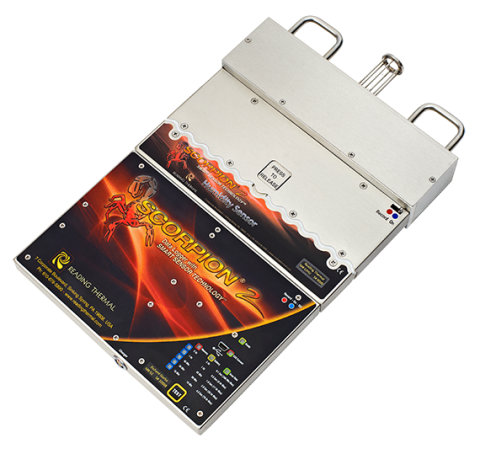As your products bake, they make use of the available temperature and humidity inside your industrial oven. Oven data loggers, such as the SCORPION® 2 Profiling System and Data Logger from Reading Thermal, help you measure and document these parameters in order to achieve the best results with your products.
Located in Sinking Spring, Pennsylvania, Reading Thermal has focused on measuring and understanding the commercial baking process for over 25 years. We manufacture the SCORPION® 2 Profiling System and Data Logger, which is a standard in the baking industry and offers you an easy way to monitor actual oven in-process conditions.
Connecting our different smart sensors and sensor arrays to the SCORPION® 2 Data Logger and passing them through the oven with your product enables the system to capture the four main baking parameters: temperature (including the temperature of both the air and the oven belt surface), heat flux (energy transfer), humidity, and airflow (velocity).
Measure Essential Baking Parameters
1) Temperature: Oven temperature impacts oven-spring, drying/dehydration, and color formation during baking. Temperatures that are too low or too high can also lead to unwelcome changes in product texture and taste. The Scorpion® 2 Temperature Sensor Array measures temperatures at product level, in fixed positions across the conveyor, and delivers a precise picture of temperatures from side-to-side and end-to-end.
2) Humidity: Humidity is the amount of water vapor in the air. As your products bake, they use the available moisture inside the oven. Without humidity, the quality and texture of your products will not turn out as expected. High oven humidity can lighten the crust color of baked goods and prevent it from burning. Lower humidity typically results in crustier bread. Global bakeries trust the SCORPION® 2 Humidity Sensor, to accurately measure the absolute moisture content of the thermal environment in heating and cooling processes.
3) Heat flux: Many product characteristics are defined by the amount and type of heat that is applied during the baking process. The differences explain why one oven bakes differently than another. And analyzing and controlling these differences is important in understanding how they will affect the finished characteristics of a product. The SCORPION® 2 Heat Flux Sensor measures radiant and heat fluxes at product level and displays the results in Btu/hr·ft2 or convective W/m2.
4) Air velocity: In a convection oven, airflow comes primarily from the air distribution plenums. In a radiant oven, it comes from the moving conveyor, the exhaust system, and natural combustion air currents. Measuring oven air velocity with the SCORPION® 2 Air Velocity Sensor is critical because airflow influences the texture, firmness, coloration, and baking time of the final product. The profiles will help you spot airflow differences between baking zones and undesirable air currents at the entrance or exit of the oven that can cause inconsistent baking.
Explore what is happening inside your commercial bakery ovens. Temperature and humidity profiling with the SCORPION® 2 Profiling System and Data Logger from Reading Thermal and our innovative sensors and sensor arrays can help you improve your products and processes. Contact us online, or call us at (610) 678-5890 Ext. 2 to learn more.

